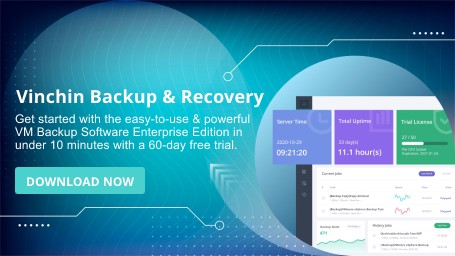-
Property Casualty Data Characteristics
-
Property Casualty Backup Challenges
-
Common Backup Methods in Property Casualty Insurance
-
Vinchin’s Data Protection Solution for Property Casualty Insurance
-
Property Casualty Data Backup FAQs
-
Conclusion
In the property and casualty insurance industry, data is the backbone of every operation. From processing claims to managing policies, insurers rely on vast amounts of sensitive information. A robust property casualty data backup solution is not just a technical requirement—it is essential for meeting regulatory demands, maintaining customer trust, and ensuring business continuity. In this article, we will explore the unique characteristics of property and casualty insurance data, the challenges of backing it up, the most common backup methods, and how modern solutions like Vinchin can help insurers protect their critical assets.
Property Casualty Data Characteristics
Property and casualty insurers handle a remarkable volume and variety of data. As digital transformation accelerates, the scale of records grows rapidly with each new policyholder and claim. Insurers use policy administration systems, claims processing platforms, and customer relationship management tools, all of which generate and store data daily.
This data is highly sensitive. It includes personal information such as names, addresses, financial details, and even medical records. Because of legal and regulatory requirements, insurers must retain much of this data for many years—sometimes decades. The formats are diverse, ranging from structured databases to scanned documents, images, emails, and even voice recordings. Managing such a mix of data types while ensuring long-term retention and security is a unique challenge for the industry.
Property Casualty Backup Challenges
Implementing a property casualty data backup solution comes with several hurdles. One major issue is legacy system integration. Many insurers still rely on older platforms that may not support modern backup technologies, making seamless data protection difficult.
Another challenge is large-scale unstructured data. With so many data types and sources, organizing and backing up everything efficiently can strain both storage and network resources. Insurers must also be ready for the unexpected; so disaster recovery readiness is a top priority. This means having systems in place to restore operations quickly after events like cyberattacks, hardware failures or natural disasters.
Compliance is another critical factor. Insurers must follow data privacy laws such as GDPR and CCPA as well as insurance-specific regulations set by authorities like NAIC. These rules dictate how data is stored protected accessed adding another layer of complexity to backup strategies.
Common Backup Methods in Property Casualty Insurance
Insurers use several methods to protect their data. The most traditional is on-premises tape/disk backups—storing copies on physical media within company facilities offers control but can be vulnerable to local disasters or hardware failures.
Many organizations now turn to cloud-based backups, storing information in secure remote centers for protection against local incidents while enabling rapid recovery from anywhere; cloud backups also offer scalability for growing volumes.
A popular approach combines both: the hybrid cloud/on-premises strategy keeps critical frequently accessed files onsite while long-term or disaster-recovery copies go into cloud storage—balancing performance cost resilience suited perfectly for complex insurer needs.
Vinchin’s Data Protection Solution for Property Casualty Insurance
Vinchin has already delivered data protection solutions to numerous enterprises in the property and casualty insurance industry. Vinchin is compatible with over 19 virtualization platforms—including VMware, Hyper-V, and Proxmox—as well as physical servers, databases, and both on-premises and cloud file storage. This broad compatibility meets the diverse IT architecture needs of insurers.
If you need to perform migrations, Vinchin Backup & Recovery offers flexible and easy migration capabilities, allowing full-system migrations across any supported virtual, physical, or cloud hosts. For critical workloads on virtual or physical machines, real-time backup and replication provide extra recovery points and automated failover, reducing both RPO (Recovery Point Objective) and RTO (Recovery Time Objective).
To ensure backup reliability, Vinchin supports automatic integrity checks of backup data and validates recoverability in an isolated environment. It can also build a highly resilient disaster-recovery system by applying automated data-retention policies, archiving or backing up to the cloud, and establishing remote replicas or DR centers—ensuring rapid recovery of critical operations.
With a simple B/S web console and wizard-driven workflows, users can quickly create backup jobs. Vinchin Backup & Recovery is available for a 60-day free trial; comprehensive documentation and patient support engineers help you deploy your backup system efficiently.
Property Casualty Data Backup FAQs
Q1: How can insurers ensure compliance with strict data retention regulations when using a backup solution?
A1: By setting custom retention policies and using solutions that support regulatory requirements; insurers can meet legal obligations for data storage.
Q2: What should a property-and-casualty insurer do if ransomware encrypts both primary-and-backup-data?
A2: Use solutions with immutable storage plus offsite copies so clean recovery points are always available.
Q3: How can legacy systems be included in modern strategies without disrupting daily operations?
A3: Choose solutions supporting integration with older platforms so legacy-data stays protected while business continues smoothly.
Conclusion
A strong property casualty data backup solution is vital for today’s insurers. With growing volumes strict regulations evolving threats only robust flexible reliable strategies will do. Vinchin stands out as an effective optionfor those seekingto protecttheir most valuable digital assets.
Share on:







